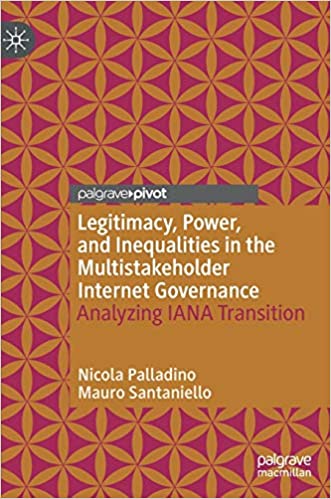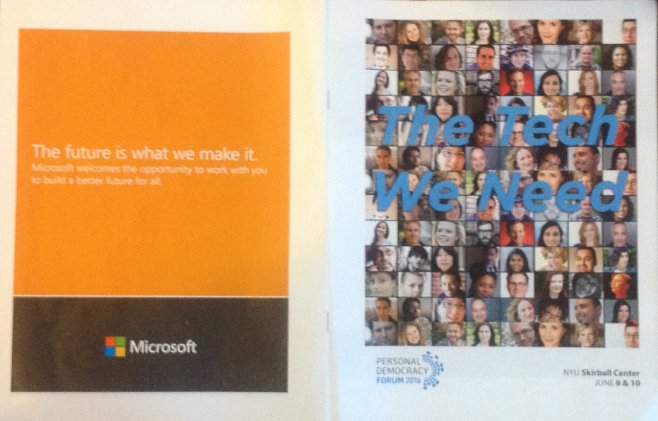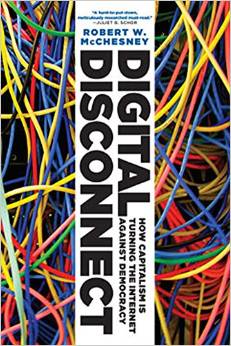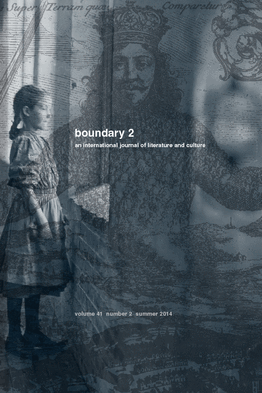a review of Nicola Palladino and Mauro Santaniello, Legitimacy, Power, and Inequalities in the Multistakeholder Internet Governance: Analyzing IANA Transition (Palgrave MacMillan, 2020)
by Richard Hill
~
While multistakeholder processes have long existed (see the Annex of this submission to an ITU group), they have recently been promoted as a better alternative to traditional governance mechanisms, in particular at the international level; and Internet governance has been put forward as an example of how multistakeholder processes work well, and better than traditional governmental processes. Thus it is very appropriate that a detailed analysis be made of a recent, highly visible, allegedly multistakeholder process: the process by which the US government relinquished its formal control over the administration of Internet names and address. That process was labelled the “IANA transition.”
The authors are researchers at, respectively, the School of law and Governance, Dublin City University; and the Internet & Communication Policy Center, Department of Political and Social Studies, University of Salerno, Italy. They have taken part in several national and international research projects on Internet Governance, Internet Policy and Digital Constitutionalism processes. They have methodically examined various aspects of the IANA (Internet Assigned Numbers Authority) transition, and collected and analysed an impressive body of data regarding who actually participated in, and influenced, the transition process. Their research confirms what others have stated, namely that the process was dominated by insiders with vested interests, that the outcome did not resolve long-standing political issues, and that the process cannot by any means be seen as an example of an ideal multistakeholder process, and this despite claims to the contrary by the architects of the IANA transition.
As the authors put the matter: “For those who believe that the IANA is a business concerning exclusively or primarily ICANN [Internet Corporations for Assigned Names and Numbers], the IETF [Internet Engineering Task Force], the NRO [Numbering Resource Organization], and their respective communities, the IANA transition process could be considered inclusive and fair enough, and its outcome effectively transferring the stewardship over IANA functions to the global stakeholder’s community of reference. For those who believe that the IANA stakeholders extend far beyond the organizations mentioned above, the assessment can only have a negative result” (146). Because “in the end, rather than transferring the stewardship of IANA functions to a new multistakeholder body that controls the IANA operator (ICANN), the transition process allowed the ICANN multistakeholder community to perform the oversight role that once belonged to the NTIA [the US government]” (146). Indeed “in the end, the novel governance arrangements strengthened the position of the registries and the technical community” (148). And the US government could still exercise ultimate control, because “ICANN, the PTI [Post-Transition IANA], and most of the root server organizations remain on US territory, and therefore under US jurisdiction” (149).
That is, the transition failed to address the key political issue: “the IANA functions are at the heart of the DNS [Domain Name System] and the Internet as we know it. Thus, their governance and performance affect a vast range of actors [other than the technical and business communities involved in the operation of the DNS] that should be considered legitimate stakeholders” (147). Instead, it was one more example of “the rhetorical use of the multistakeholder discourse. In particular, … through a neoliberal discourse, the key organizations already involved in the DNS regime were able to use the ambiguity of the concept of a ‘global multistakeholder community’ as a strategic power resource.” Thus failing fully to ensure that discussions “take place through an open process with the participation of all stakeholders extending beyond the ICANN community.” While the call for participation in the process was formally open “its addressees were already identified as specific organizations. It is worth noting that these organizations did not involve external actors in the set-up phase. Rather, they only allowed other interested parties to take part in the discussion according to their rules and with minor participatory rights [speaking, but non-voting, observers]” (148).
Thus, the authors’ “analysis suggests that the transition did not result in, nor did it lead to, a higher form of multistakeholderism filling the gap between reality and the ideal-type of what multistakeholderism ought to be, according to normative standards of legitimacy. Nor was it able to fix the well-known limitations in inclusiveness, fairness of the decision-making process, and accountability of the entire DNS regime. … Instead, the transition seems to have solidified previous dominant positions and ratified the ownership of an essential public function by a private corporation, led by interwoven economic and technical interests” (149). In particular, “the transition process showed the irrelevance of civil society, little and badly represented in the stakeholder structure before and after the transition” (150). And “multistakeholderism [in this case] seems to have resulted in misleading rhetoric legitimizing power asymmetries embedded within the institutional design of DNS management, rather than in a new governance model capable of ensuring the meaningful participation of all the interested parties.”
In summary, the IANA transition is one more example of the failure of multistakeholder processes to achieve their desired goal. As the authors correctly note: “Initiatives supposed to be multistakeholder have often been criticized for not complying with their premises, resulting in ‘de-politicization mechanisms that limit political expression and struggle’” (153). Indeed, “While multistakeholderism is used as a rhetoric to solidify and legitimize power positions within some policy-making arena, without any mechanisms giving up power to weaker stakeholders and without making concrete efforts to include different discourses, it will continue to produce ambiguous compromises without decisions, or make decisions affected by a poor degree of pluralism” (153). As others have stated, “‘multistakeholderism reinforces existing power dynamics that have been ‘baked in’ to the model from the beginning. It privileges north-western governments, particularly the US, as well as the US private sector.’ Similarly, … multistakeholderism [can be defined] as a discursive tool employed to create consensus around the hegemony of a power élite” (12). As the authors starkly put the matter, “multistakeholder discourse could result in misleading rhetoric that solidifies power asymmetries and masks domination, manipulation, and hegemonic practices” (26). In particular because “election and engagement procedures often tend to favor an already like-minded set of collective and individual actors even if they belong to different stakeholder categories” (30).
The above conclusions are supported by detailed, well referenced, descriptions and analyses. Chapters One and Two explain the basic context of the IANA transition, Internet governance and their relation to multistakeholder processes. Chapter One “points out how multistakeholderism is a fuzzy concept that has led to ambiguous practices and disappointing results. Further, it highlights the discursive and legitimizing nature of multistakeholderism, which can serve both as a performing narrative capable of democratizing the Internet governance domain, as well as a misleading rhetoric solidifying the dominant position of the most powerful actors in different Internet policy-making arenas” (1). It traces the history of multistakeholder governance in the Internet context, which started in 2003 (however, a broader historical context would have been useful, see the Annex of this submission to an ITU group). It discusses the conflict between developed and developing countries regarding the management and administration of domain names and addresses that dominated the discussions at the World Summit on the Information Society (WSIS) (Mueller’s Networks and States gives a more detailed account, explaining how development issues – which were supposed to be the focus of the WSIS – got pushed aside, thus resulting in the focus on Internet governance). As the authors correctly state, “the outcomes of the WSIS left the tensions surrounding Internet governance unresolved, giving rise to contestation in subsequent years and to the cyclical recurrence of political conflicts challenging the consensus around the multistakeholder model” (5). The IANA transition was seen as a way of resolving these tensions, but it relied “on the conflation of the multistakeholder approach with the privatization of Internet governance” (8).
As the authors posit (citing well-know scholar Hoffmann, “multistakeholderism is a narrative based on three main promises: the promise of achieving global representation on an issue putting together all the affected parties; the promise of overcoming the traditional democratic deficit at the transnational level, ‘establishing communities of interest as a digitally enabled equivalent to territorial constituencies’; and the promise of higher and enforced outcomes since incorporating global views on the matter through a consensual approach should ensure more complete solutions and their smooth implementation” (10).
Chapter Three provides a thorough introduction to the management of Internet domain names and address and of the issues related to it and to the IANA function, in particular the role of the US government and of US academic and business organizations; the seminal work of the Internet Ad Hoc Group (IAHC); the creation and evolution of ICANN; and various criticism of ICANN, in particular regarding its accountability. (The chapter inexplicably fails to mention the key role of Mocakpetris in the creation of the DNS).
Chapter Four describes the institutional setup of the IANA transition, and the constraints unilaterally imposed by the US government (see also 104) and the various parties that dominate discussions of the issues involved. As the authors note, the call for the creation of the key group went out “without having before voted on the proposed scheme [of the group], neither within the ICANN community nor outside through a further round of public comments” (67). The structure of that group heavily influenced the discussions and the outcome.
Chapter Five evaluates the IANA transition in terms of one of three types of legitimacy: input legitimacy, that is whether all affected parties could meaningfully participate in the process (the other two types of legitimacy are discussed in subsequent chapters, see below). By analysing in detail the profiles and affiliations of the participants with decision-making power, the authors find that “a vast majority (56) of the people who have taken part in the drafting of the IANA transition proposal are bearers of technical and operative interests” (87); “Regarding nationality, Western countries appear to be over-represented within the drafting and decisional organism involved in the IANA transition process. In particular, US citizens constitute the most remarkable group, occupying 20 seats over 90 available” (89); and “IANA transition voting members experienced multiple and trans-sectoral affiliations, blurring the boundaries among stakeholder categories” (151). In summary “the results of this stakeholder analysis seem to indicate that the adopted categorization and appointment procedures have reproduced within the IANA transition process well-known power relationships and imbalances already existing in the DNS management, overrepresenting Western, technical, and business interests while marginalizing developing countries and civil society participation” (90).
Chapter Six evaluates the transition with respect to process legitimacy: whether all participants could meaningfully affect the outcome. As the authors correctly note, “Stakeholders not belonging to the organizations at the core of the operational communities were called to join the process according to rules and procedures that they had not contributed to creating, and with minor participatory rights” (107). The decision-making process was complex, and undermined the inputs from weaker parties – thus funded, dedicated participants were more influential. Further, key participants were concerned about how the US government would view the outcome, and whether it would approve it (116). And discussions appear to have been restricted to a neo-liberal framework and technical framework (120, 121). As the authors state: “Ultimately, this narrow technical frame prevented the acknowledgment of the public good nature of the IANA functions, and, even more, of their essence as public policy issues” (121). Further, “most members and participants at the CWG-Stewardship had been socialized to the ICANN system, belonging to one of its structures or attending its meetings” and “the long-standing neoliberal plan of the US government and the NTIA to ‘privatize’ the DNS placed the IANA transition within a precise system of definitions, concepts, references, and assumptions that constrained the development of alternative policy discourses and limited the political action of sovereignist and constitutional coalitions” (122).
Thus, it is not surprising that the authors find that “a single discourse shaped the deliberation. These results contradict the assumptions at the basis of the multistakeholder model of governance, which is supposed to reach a higher and more complete understanding of a particular matter through deliberation among different categories of actors, with different backgrounds, views, and perspectives. Instead, the set of IANA transition voting members in many regards resembled what has been defined as a ‘club governance’ model, which refers to an ‘elite community where the members are motivated by peer recognition and a common goal in line with values, they consider honourable’” (151).
Chapter Seven evaluates the transition with respect to output legitimacy: whether the result achieved its goals of transferring oversight of the IANA function to a global multistakeholder community. As the authors state “ the institutional effectiveness of the IANA transition cannot be evaluated as satisfying from a normative point of view in terms of inclusiveness, balanced representation, and accountability. As a consequence, the ICANN board remains the expression of interwoven business and technical interests and is unlikely to be truly constrained by an independent entity” (135). Further, as shown in detail, “the political problems connected to the IANA functions have been left unresolved, … it did not take a long time before they re-emerged” (153).
Indeed, “IANA was, first of all, a political matter. Indeed, the transition was settled as a consequence of a political fact – the widespread loss of trust in the USA as the caretaker of the Internet after the Snowden disclosures. Further, the IANA transition process aimed to achieve eminently political goals, such as establishing a novel governance setting and strengthening the DNS’s accountability and legitimacy” (152). However, as the authors explain in detail, the IANA transition was turned into a technical discussion, and “The problem here is that governance settings, such as those described as club governance, base their legitimacy form professional expertise and reputation. They are well-suited to performing some form of ‘technocratic’ governance, addressing an issue with a problem-solving approach based on an already given understanding of the nature of the problem and of the goals to be reached. Sharing a set of overlapping and compatible views is the cue that puts together these networks of experts. Nevertheless, they are ill-suited for tackling political problems, which, by definition, deal with pluralism” (152).
Chapter Seven could have benefitted from a discussion of ICANN’s new Independent Review Process, and the length of time it has taken to put into place the process to name the panellists.
Chapter Eight, already summarized above, presents overall conclusions.
In summary, this is a timely and important book that provides objective data and analyses of a particular process that has been put forward as a model for multistakeholder governance, which itself has been put forth as a better alternative to conventional governance. While there is no doubt that ICANN, and the IANA function, are performing their intended functions, the book shows that the IANA transition was not a model multistakeholder process: on the contrary, it exhibited many of the well-known flaws of multistakeholder processes. Thus it should not be used as a model for future governance.
_____
Richard Hill is President of the Association for Proper internet Governance, and was formerly a senior official at the International Telecommunication Union (ITU). He has been involved in internet governance issues since the inception of the internet and is now an activist in that area, speaking, publishing, and contributing to discussions in various forums. Among other works he is the author of The New International Telecommunication Regulations and the Internet: A Commentary and Legislative History (Springer, 2014). He writes frequently about internet governance issues for The b2o Review Digital Studies magazine.










